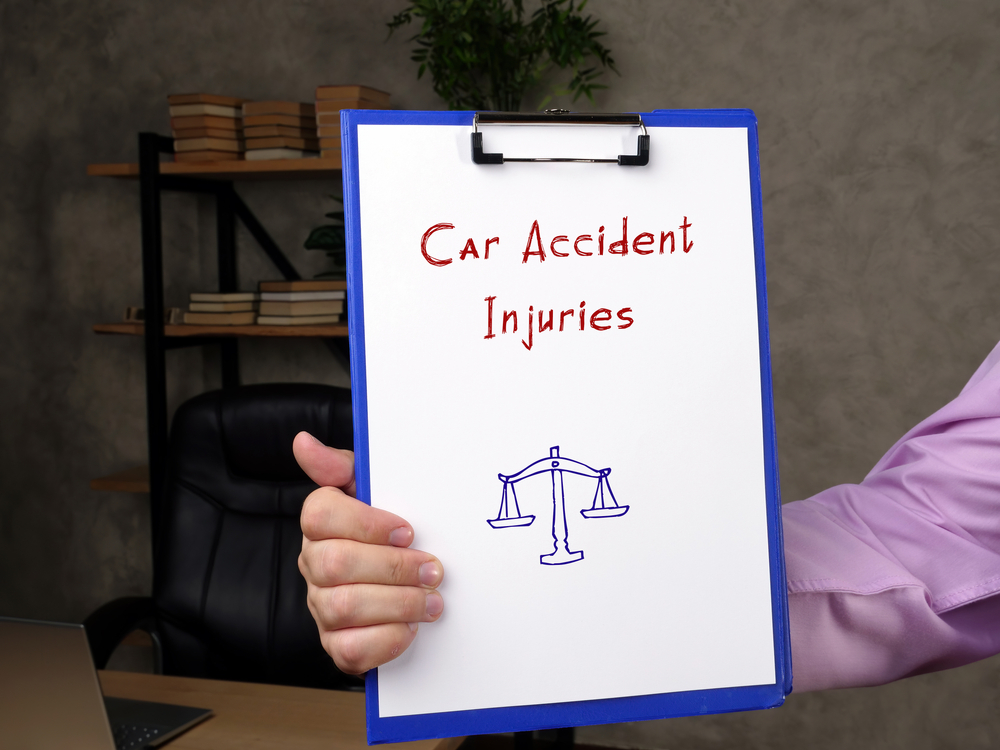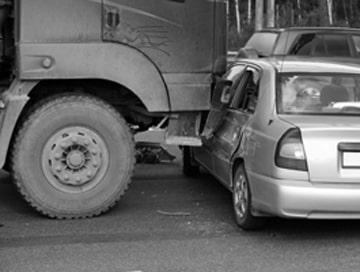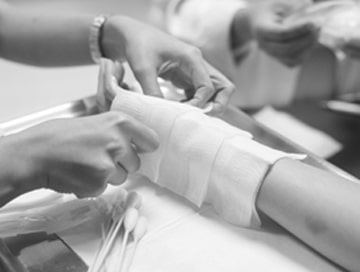
Did you know car accidents are like snowflakes? No two are exactly alike! However, when it comes to injuries sustained, we see striking similarities. Now, let’s take a dive into the sometimes scary world of vehicular mishap-related injuries: from the garden-variety to the downright bone-crushing.
Car accidents, an unfortunate regular occurrence globally, lead to millions of injuries annually, accounting for prolonged hospital stays and massive medical costs. Enhancing our understanding of common accidents and their associated injuries allows victims and their families to better navigate post-accident scenarios, ensuring critical care and rightful compensation.
Types of Car Accidents and Common Injuries
Various forms of car accidents exist, with the severity and type of injuries largely being contingent upon the nature of the collision. Below, we elaborate on some common accidents and their injuries:
Passenger cars & light trucks: Occupants of these vehicles often suffer from injuries such as whiplash, bone fractures, and soft-tissue damage like sprains and strains. According to the Insurance Institute for Highway Safety, in 2019, individuals inside passenger cars accounted for 60%, or 23,824 passengers, of vehicle crash deaths.
However, the landscape of road safety has majorly transformed since the introduction of seat belts. From 1975 to 2017, seat belt use is estimated to have saved approximately 374,276 lives. The NHTSA affirms that using lap and shoulder seat belts reduces the risk of front seat passenger car occupant deaths by 45% and moderate to critical injuries by 50%.
Despite the spikes of unrestrained occupant deaths during COVID-19, it’s clear that effective use of seat belts significantly improves safety. In 2021, seat belt use was recorded at 90.4%, while unrestrained occupant deaths accounted for 50% of total deaths. The data demonstrates a decline in unrestrained deaths with the increase in seat belt use.
Pedestrians and cyclists: They are extremely susceptible to severe injuries such as traumatic brain injuries, spinal cord damage, fractures, and internal injuries. As per the Crash Stats (NHTSA), almost 5,977 pedestrians were killed in traffic crashes in the United States in 2017.
Motorcycles: Riders face severe risks such as limb amputation, disfigurement, burns, and facial injuries, potentially leading to lifelong physical and emotional trauma. The NHTSA reported that 5,014 motorcyclists died in crashes in 2019.
Large trucks and buses: Due to the massive size and weight, these vehicles can cause catastrophic injuries like spinal injuries, internal organ damage, or even fatal injuries. In 2019, 5,005 large trucks were involved in fatal crashes, a slight increase from 2018.
Whiplash
Whiplash is a frequent injury in car accidents, resulting from sudden neck jerk, causing neck pain, restricted range of motion, and neck muscle damage. A study in Sweden found that after a 10-year follow-up, 71% of whiplash-associated disorder patients still reported neck pain.
Broken Bones
Impact from accidents often result in broken bones, generally affecting the arms, legs, or ribs. According to a study published in the Journal of Trauma and Acute Care Surgery, among the most frequent injuries observed in vehicle accidents were thoracic spine fractures.
Soft Tissue Injuries
Injuries like sprains and strains can inflict substantial pain and disrupt everyday life. A study published in the Annals of Rehabilitation Medicine found that acute soft tissue injuries often lead to persistent pain and disability if not properly addressed.
Traumatic brain injury (TBI)
Traumatic Brain Injury (TBI) is a serious concern in vehicle accidents. It is among the most common injuries suffered, often causing significant damage to the brain due to an abrupt jerk from the impact. According to the CDC, vehicle accidents are ranked as the third leading cause of all TBI-related hospitalizations.
Ranging from mild cases with transient symptoms such as headaches and dizziness to extremely severe cases leading to prolonged unconsciousness or comas, TBIs may exhibit varying symptoms contingent upon the brain region affected. For instance, the frontal lobe, often injured in accidents, could result in cognitive and behavioral alterations.
Immediate medical intervention is crucial to arrest further damage and expedite recovery. Treatment might involve medication to reduce swelling, surgical intervention to eliminate blood clots or mend skull fractures, and rehabilitative therapy to recover lost functions.
Concussion
Next to Traumatic Brain Injuries (TBIs), concussions are another frequently seen trauma in car accidents. As reported by the Centers for Disease Control and Prevention (CDC), motor vehicle crashes are responsible for a significant chunk of annual concussion cases. In the United States alone, roughly 3 million people each year are involved in car accidents that lead to a concussion.
A forceful blow or jolt to the head can cause the brain to sway inside the skull, culminating in a concussion. Notably, the symptoms might not be immediately apparent, underscoring the imperative for accident victims to have a medical check-up following a mishap, irrespective of their immediate feelings.
The repercussions of an untreated concussion can be damaging and long-lasting. Even if considered mild, concussions should not be overlooked. Those afflicted may experience symptoms ranging from headaches, dizziness, nausea, difficulty in concentrating to memory problems, and mood changes.
Thorough medical examination and correct treatment are paramount for concussion victims. A healthcare expert could carry out requisite tests, diagnose a concussion, and design an individualized treatment regimen. Timely medical attention also ensures prompt management of any potential concussion-related complications such as brain swelling or hemorrhage.
Concussions are a common and serious outcome of car accidents. By seeking immediate medical care and adhering to an appropriate treatment plan, victims can mitigate possible long-term effects of this traumatic injury.
Spinal Cord Injuries
Spinal cord injuries regularly emerge as one of the most common yet devastating car accident outcomes. The severity of these traumas can span from minor conditions like herniated discs to grave ones such as paralysis. Each year in the USA, nearly 17,730 new cases of spinal cord injuries stem from car accidents, accounting for about 38.3% of all spinal cord injuries.
Sudden, forceful movements of the neck and back during a car accident can evoke damage to the spinal cord, a delicate structure responsible for transmitting messages between the brain and the body. This transmission can be affected by a variety of injury types.
Mild spinal cord injuries often take the form of herniated discs, when the cushion-like discs between vertebrae rupture or are displaced. Though painful and in need of treatment, these injuries usually do not impose long-term complications.
On the contrary, severe spinal cord injuries can cause partial to full paralysis depending on injury location and magnitude. These occur when cord damage impairs brain-body communication.
What demands particular attention is that spinal cord injuries can drastically alter an individual’s life. Beyond paralysis, victims may face symptoms such as sensory loss, limited mobility, constant pain, and muscle weakness.
Car accidents inducing spinal cord injuries also bear a risk of fatality, escalating with injury severity and extent. Hence, immediate medical consultation is crucial to assess the injury and administer the appropriate treatment. In summary, spinal cord injuries can substantially impact car accident victims’ lives. Identifying injury types and severity bears significance in rendering suitable medical care and support.
Heart Attacks
An unexpected yet perilous injury that may arise from car accidents. The stress and trauma linked with such circumstances can instigate heart attacks, particularly among individuals aged above 65. It’s estimated that nearly 1.5 million heart attacks and strokes occur every year in the United States, and vehicular accidents bear a significant share.
A study done by the National Institutes of Health sheds light on the fact that post-collision, heart attack risks can remain heightened for weeks and even months. Escalated stress can spur increased secretion of stress hormones thereby altering blood pressure and heart rate. For individuals with pre-existing cardiovascular conditions, these changes can culminate in a heart attack.
Being cognizant of the heightened potential for a heart attack is crucial for accident victims. Watch for symptoms such as chest pain, breathlessness, nausea, and fatigue. Quick medical help is paramount if these symptoms emerge, as rapid assistance drastically improves prognosis and recovery chances.
The repercussions of car accidents transcend obvious physical injuries and extend to the possible onset of heart attacks. Particularly aged individuals should take note of this added risk, and seek urgent medical help if symptomatic. By acknowledging the car accident-heart attack correlation, victims can fast-track crucial, lifesaving medical interventions.
Facial Injuries
Counted among the most common and worst car crash injuries, often emerge during car wrecks. The National Highway Traffic Safety Administration (NHTSA) states that approximately 54% of all car accidents involve facial injuries. Car accident injuries in this category can range from minor cuts and bruises to major incidents such as fractures, lacerations, and even disfigurement.
Car accident injury-related facial traumas can be attributed to various factors. High-impact collisions can cause drivers or passengers to collide with objects like the steering wheel, dashboard, or windshield, resulting in facial injuries. Moreover, shattered glass or debris from the car crash can inflict cuts and lacerations on the face.
Long-term effects of such facial injuries can be severe. Significant damage may lead to scarring, disfigurement, and limited movement. Consequently, reconstructive and plastic surgeries could be essential to restoring the face’s functionality and aesthetics, minimizing scarring, re-establishing facial symmetry, and improving overall facial appearance.
Besides physical consequences, facial injuries can elicit psychological impacts as well. Emotional distress, self-esteem issues, and depression may arise from facial disfigurement. Psychological support and counseling could be crucial for those grappling with the aftermath of a facial accident injury.
How Much Are Car Accident Injuries Worth?
Car accidents can lead to a myriad of injuries, some with deep-seated effects on victims. These injuries can have profound impacts on a person’s physical, emotional, and financial well-being. Understanding the prevalent car accident injuries can empower victims to seek appropriate medical treatment and legal recourse if necessary.
According to a study by the National Highway Traffic Safety Administration (NHTSA), the most common injuries from car accidents include:
- Traumatic brain injuries that typically occur when the head strikes an object, leading to cognitive impairments and neurological deficits.
- Spinal cord injuries, which can trigger partial or complete paralysis, depending on the severity and location of the injury.
- Broken bones, typically resulting from the collision’s impact.
- Soft tissue injuries like sprains, strains, and contusions, caused by sudden jerking movements during the accident.
The worth of car accident injuries varies based on factors like:
- The severity of the injuries,
- The effect on the individual’s personal life,
- Associated medical expenses and lost wages.
Moreover, aspects like pain, suffering, and property damage are taken into account when calculating compensation. Other determinants of car accident injury value include the degree of shared fault, the strength of the victim’s case, and the decision to settle or litigate.
Victims must consult with healthcare professionals to assess their injuries and ensure appropriate medical care.
How to Secure Compensation for Car Crash Injuries
Have you been injured in a car accident? You may be qualified for compensation that caters to your injuries and any associated losses. The recompense process can seem daunting, understanding its intricacies can make navigating the legal system and securing the right financial support, a smoother process.
Let’s break down how to obtain compensation for your car crash injury:
- Secure Medical Treatment: Always prioritize immediate medical treatment following a car accident. This safeguards your health and creates a vital record of your injuries which can lend support to your case during legal proceedings.
- Compilation of Evidence: Build a substantial claim by accumulating as much evidence as you can. This involves several steps. Begin by securing the police report and gathering witness statements. Then, photograph the accident site and your injuries. Finally, ensure to retain all medical bills and records.
- Consult an Attorney: It’s advisable to seek counsel from an experienced personal injury attorney. They will guide you through the entire legal procedure and negotiate on your behalf with the at-fault driver’s insurance company. Additionally, they will assist in strengthening your case.
- Successful Settlement Negotiation: Working hand in hand with your attorney, you can negotiate an equitable settlement with the insurance company of the responsible driver. This can include a comprehensive tally of medical expenses, lost wage, pain, suffering, and other damages.
- Presenting Your Case in Court: If you find yourself unable to reach a fair settlement, your attorney might recommend that you pursue the case in court. Here, your attorney will champion your cause before a judge or jury to secure you justly deserved compensation.
Your compensation amount rests on various factors, including your losses, the shared blame in the accident, the robustness of your case, and the choice between settling or suing.
As per the Insurance Research Council, about 95% of personal injury claims are settled pretrial, indicating the success of this process. Therefore, remember to seek out expert legal advice, and maintain a comprehensive record of your experiences post-accident.
Don’t Wait, Get Help!
Car accidents often result in a range of injuries, from mild to severe – all warranting immediate healthcare attention. It is crucial for victims to procure swift medical treatment, facilitating a full understanding of their injuries and ensuring they receive suitable therapy.
According to a report by the Association for Safe International Road Travel, nearly 4.4 million Americans are injured seriously enough in crashes to require medical attention. Such statistics reiterate the gravity of seeking timely healthcare aid following a car accident.
Further, it’s quintessential to collaborate with a seasoned legal expert who can illuminate victims about their rights and potential avenues for compensation. Car accidents not only induce physical affliction but also beget significant emotional and financial stressors. In fact, cost of car accidents in the U.S. eclipses $230.6 billion per year – or an average of $820 per person, underscoring the economic impact and the dire need for rightful compensation.This is where Kuzyk Law, based in Bakersfield, California, steps in. By providing qualified legal assistance, they help you tackle the challenges that follow a car accident and support you along your journey to rebuild your life. Don’t wait, contact them today and let the experts handle your claims while you focus on your recovery.













